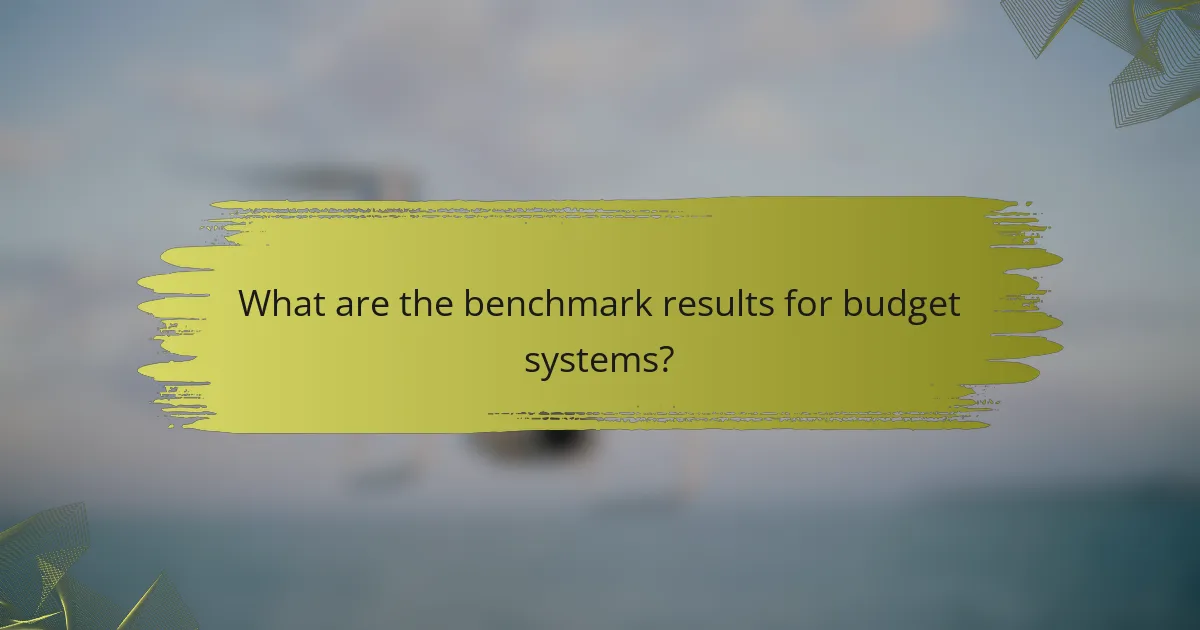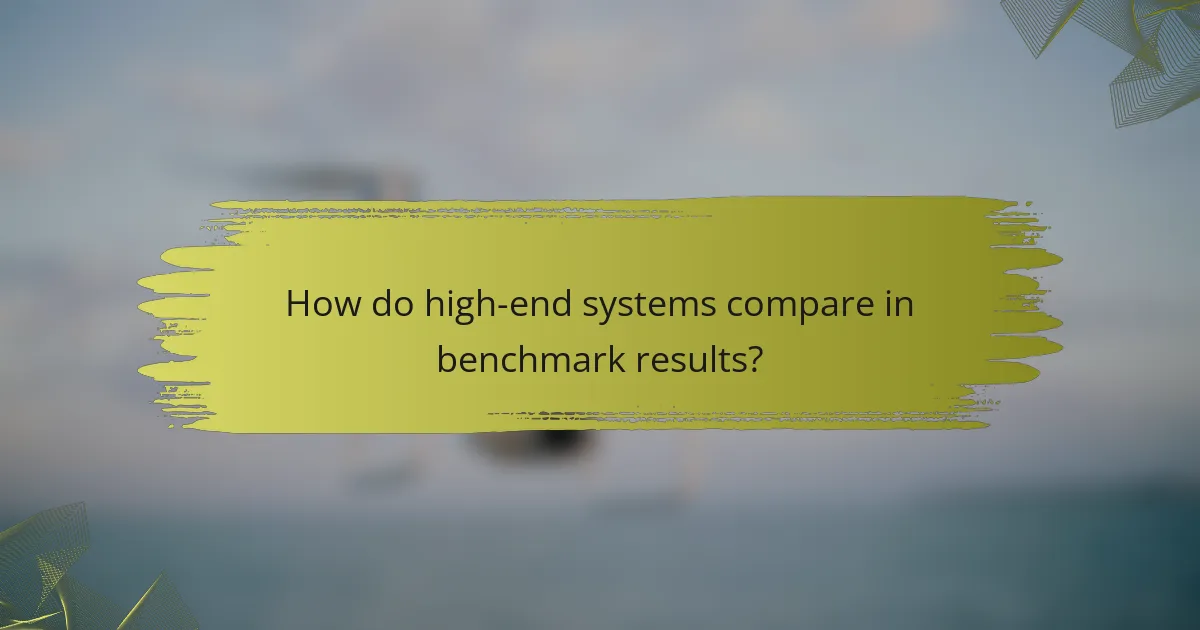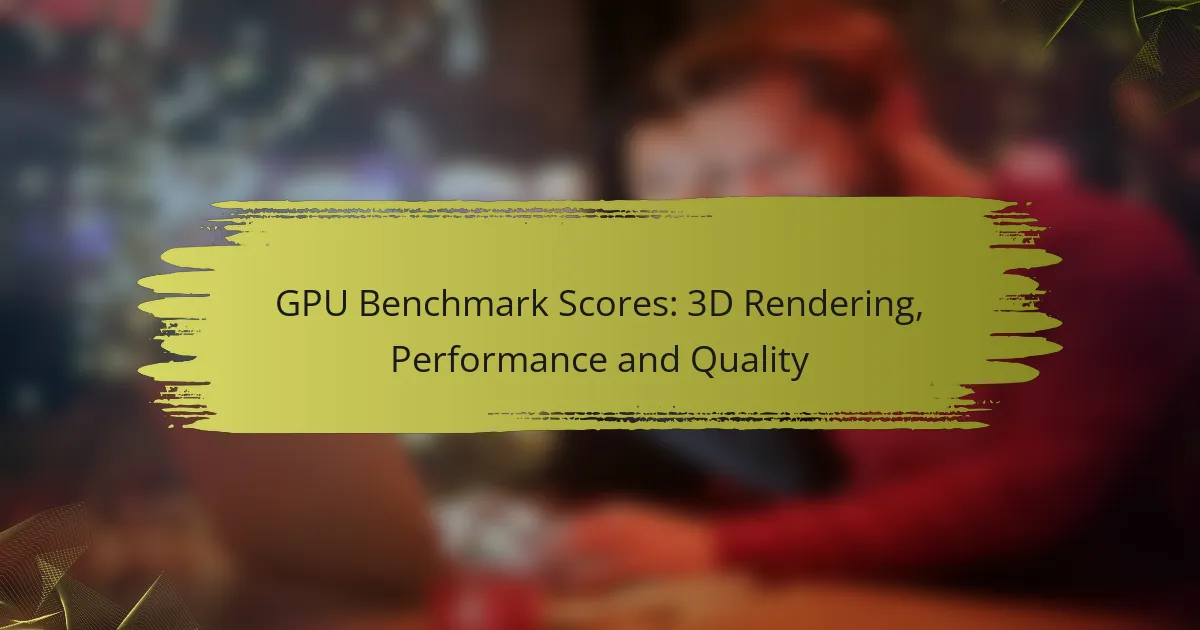Benchmark results reveal a clear distinction between budget and high-end systems, highlighting their respective strengths and weaknesses. Budget systems provide adequate performance for everyday tasks at a lower cost, while high-end systems excel in processing power and graphics capabilities, catering to demanding applications. Understanding the value proposition of each can help consumers make informed decisions based on their specific needs and budget constraints.

What are the benchmark results for budget systems?
Benchmark results for budget systems indicate that these setups can deliver satisfactory performance for everyday tasks at a lower cost. Typically, budget systems excel in basic operations but may struggle with high-demand applications compared to more expensive options.
Performance metrics of budget systems
Budget systems often achieve performance metrics that are adequate for general use, such as web browsing, document editing, and media consumption. They usually feature processors that can handle low to moderate workloads, with benchmark scores often falling in the mid-range on platforms like PassMark or Cinebench.
However, users should expect longer load times and reduced frame rates in gaming or graphic-intensive applications. For instance, a budget system might score around 3,000 to 5,000 on PassMark, which is suitable for casual users but may not satisfy gamers or professionals requiring high performance.
Cost-effectiveness analysis
Cost-effectiveness in budget systems is primarily determined by their price-to-performance ratio. Generally, these systems range from $300 to $600, making them accessible for students and casual users. When evaluating cost-effectiveness, consider both the initial purchase price and the potential longevity of the hardware.
Investing in a budget system can be wise if your needs are basic. However, if you anticipate needing more power in the future, it may be worth considering a mid-range option that offers better performance longevity.
Top budget systems in 2023
Some of the top budget systems in 2023 include models like the Acer Aspire 5, Lenovo IdeaPad 3, and HP Pavilion x360. These systems typically offer a good balance of performance and affordability, with prices ranging from $400 to $600.
When choosing a budget system, look for features such as SSD storage for faster boot times, at least 8GB of RAM for multitasking, and a decent battery life of around 6 to 8 hours. These specifications will ensure a smoother user experience without breaking the bank.

How do high-end systems compare in benchmark results?
High-end systems typically outperform budget systems in benchmark results, showcasing superior processing power, graphics capabilities, and overall efficiency. These systems are designed for demanding tasks such as gaming, video editing, and data analysis, making them ideal for professionals and enthusiasts.
Performance metrics of high-end systems
Performance metrics for high-end systems often include benchmarks like CPU speed, GPU performance, and memory bandwidth. These metrics are measured using standardized tests such as Cinebench for CPU and 3DMark for graphics, providing a clear picture of a system’s capabilities.
For instance, high-end CPUs can achieve multi-core scores in the thousands, while GPUs may reach frame rates exceeding 100 FPS in demanding games at high settings. Users should consider these metrics when evaluating systems for specific applications.
Cost-benefit analysis of high-end systems
Investing in high-end systems usually entails a higher upfront cost, often ranging from several hundred to several thousand USD. However, the benefits include faster processing times and enhanced performance in resource-intensive tasks, which can lead to increased productivity and efficiency.
When assessing cost-effectiveness, consider the longevity of the investment. High-end systems tend to remain relevant longer than budget models, potentially saving money in the long run by delaying the need for upgrades.
Leading high-end systems in 2023
As of 2023, some of the leading high-end systems include models from brands like Alienware, Razer, and ASUS. These systems often feature the latest processors, such as Intel’s Core i9 or AMD’s Ryzen 9, paired with high-performance GPUs like NVIDIA’s RTX 4090.
When choosing a high-end system, look for configurations that balance CPU and GPU capabilities, sufficient RAM (typically 16GB or more), and fast storage options like NVMe SSDs. This combination ensures optimal performance for a wide range of applications.

What is the value proposition of budget versus high-end systems?
The value proposition of budget versus high-end systems lies in their respective performance, features, and cost-effectiveness. Budget systems typically offer essential functionalities at a lower price, while high-end systems provide advanced capabilities and superior performance, justifying their higher investment.
Value analysis of budget systems
Budget systems are designed to meet basic needs without excessive features, making them ideal for users with limited requirements or those just starting. They often range from a few hundred to a couple of thousand USD, depending on the specifications.
When evaluating budget systems, consider factors such as reliability, upgrade potential, and warranty options. While they may lack some advanced features, they can still perform adequately for everyday tasks like web browsing, document editing, and basic gaming.
Value analysis of high-end systems
High-end systems are tailored for users who demand top-tier performance, advanced graphics, and extensive multitasking capabilities. Prices for these systems can start in the low thousands and go up significantly based on components and customization.
Investing in a high-end system often means better longevity and support for demanding applications, such as video editing, gaming, and 3D rendering. These systems typically feature faster processors, more RAM, and superior graphics cards, providing a smoother and more efficient user experience.
Comparative value metrics
When comparing budget and high-end systems, consider metrics such as performance benchmarks, cost per feature, and user satisfaction ratings. Budget systems may score lower in performance but excel in cost-effectiveness, while high-end systems often justify their price with superior capabilities.
For a practical comparison, a budget system might deliver adequate performance for everyday tasks at a cost of around $500, while a high-end system could provide exceptional performance for professional applications at a price of $2,000 or more. Weighing these metrics against your specific needs will help determine the best value for your situation.

What criteria should be used to select a system?
Selecting a system requires careful consideration of performance metrics, costs, and user needs. Each criterion plays a vital role in ensuring the chosen system meets both current and future requirements effectively.
Key performance indicators
Key performance indicators (KPIs) are essential for evaluating a system’s efficiency and effectiveness. Common KPIs include processing speed, reliability, and scalability. For instance, a budget system may prioritize cost-effectiveness while a high-end system focuses on maximizing performance under heavy loads.
When assessing KPIs, consider industry standards relevant to your sector. For example, systems in finance may need to comply with strict transaction processing times, while those in retail might focus on inventory management efficiency.
Cost considerations
Cost is a critical factor in system selection, encompassing both initial purchase price and ongoing operational expenses. Budget systems typically range from a few hundred to a few thousand USD, while high-end systems can exceed tens of thousands USD depending on features and capabilities.
Evaluate total cost of ownership (TCO), which includes maintenance, support, and potential upgrade costs. Be cautious of hidden fees that may arise over time, such as licensing or training expenses.
User needs assessment
Understanding user needs is crucial for selecting a system that enhances productivity. Conduct surveys or interviews to gather insights on what features users find most valuable, such as ease of use, customization options, or integration capabilities.
Prioritize systems that align with user workflows and preferences. For example, a system that offers intuitive dashboards may be more beneficial for non-technical users compared to one that requires extensive training.

How do benchmark results vary by region?
Benchmark results for budget systems, high-end systems, and value offerings can differ significantly by region due to various factors such as market demand, local regulations, and economic conditions. Understanding these regional variations helps consumers and businesses make informed decisions when selecting systems that meet their needs.
Regional performance differences
Performance differences across regions often stem from variations in hardware availability, pricing strategies, and consumer preferences. For instance, budget systems may perform better in regions with lower labor costs, while high-end systems might be more prevalent in technology-driven markets.
Additionally, regional benchmarks can reflect the influence of local manufacturers and the types of components they prioritize, impacting overall system performance. It’s essential to consider these factors when evaluating systems based on benchmark results.
Market trends in North America
In North America, there is a strong trend towards high-performance systems, driven by industries such as gaming, content creation, and data analysis. Consumers often seek high-end systems that offer superior processing power and graphics capabilities, leading to increased demand for premium components.
Budget systems are also popular, particularly among students and small businesses looking for cost-effective solutions. However, the market is increasingly competitive, with many brands offering value-oriented products that balance performance and affordability.
Market trends in Europe
Europe exhibits a diverse market landscape, with varying preferences across countries. Northern European countries tend to favor high-end systems for professional use, while Southern European markets may lean towards budget systems due to economic constraints.
Additionally, sustainability is becoming a significant factor in purchasing decisions across Europe, influencing consumers to consider energy-efficient systems. This trend is prompting manufacturers to innovate and offer products that meet both performance and environmental standards.

What emerging trends are shaping budget and high-end systems?
Emerging trends in budget and high-end systems are primarily driven by technological advancements, shifting consumer preferences, and evolving market predictions. These factors influence how systems are developed, marketed, and utilized across various sectors.
Technological advancements
Technological advancements are crucial in shaping both budget and high-end systems. Innovations in processing power, storage solutions, and energy efficiency are making high-performance features more accessible to budget systems. For instance, the integration of solid-state drives (SSDs) in lower-priced models enhances speed and reliability, narrowing the performance gap.
Moreover, cloud computing and artificial intelligence are becoming integral to system functionality, allowing budget systems to leverage powerful resources without significant upfront investment. This trend enables users to access high-end capabilities through subscription models, making advanced technology more affordable.
Consumer preferences
Consumer preferences are shifting towards systems that offer versatility and value for money. Users are increasingly seeking budget systems that provide essential features without unnecessary frills, while high-end systems are expected to deliver exceptional performance and premium experiences. This trend is evident in the growing popularity of customizable options that allow consumers to tailor systems to their specific needs.
Additionally, sustainability is becoming a priority for many consumers, influencing their purchasing decisions. Brands that emphasize energy-efficient designs and eco-friendly materials are gaining traction, impacting both budget and high-end markets.
Future market predictions
Future market predictions indicate a continued convergence between budget and high-end systems, with technology becoming more democratized. Analysts expect that as manufacturing costs decrease and competition increases, high-end features will trickle down to budget models, making advanced technology widely available.
Furthermore, the rise of remote work and digital services is likely to drive demand for both types of systems. Companies may invest in high-end systems for performance-critical tasks while providing budget options for everyday use, creating a balanced market that caters to diverse needs.



